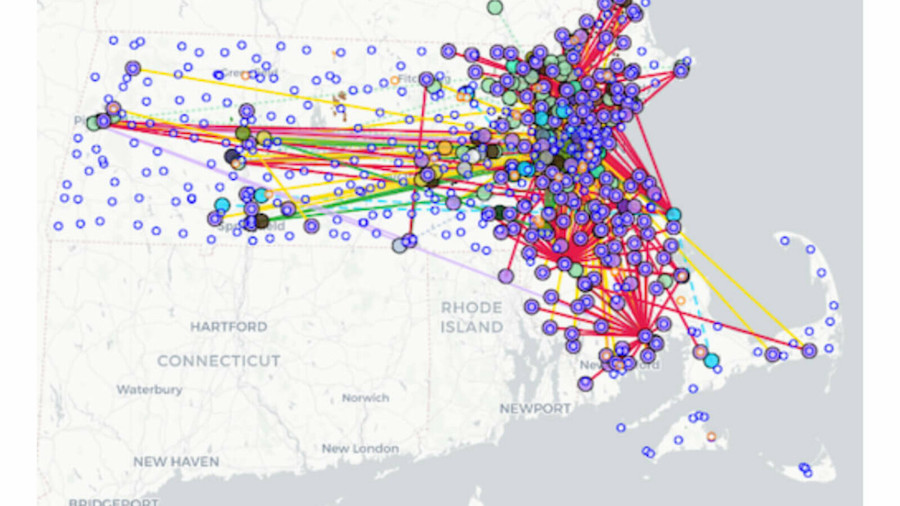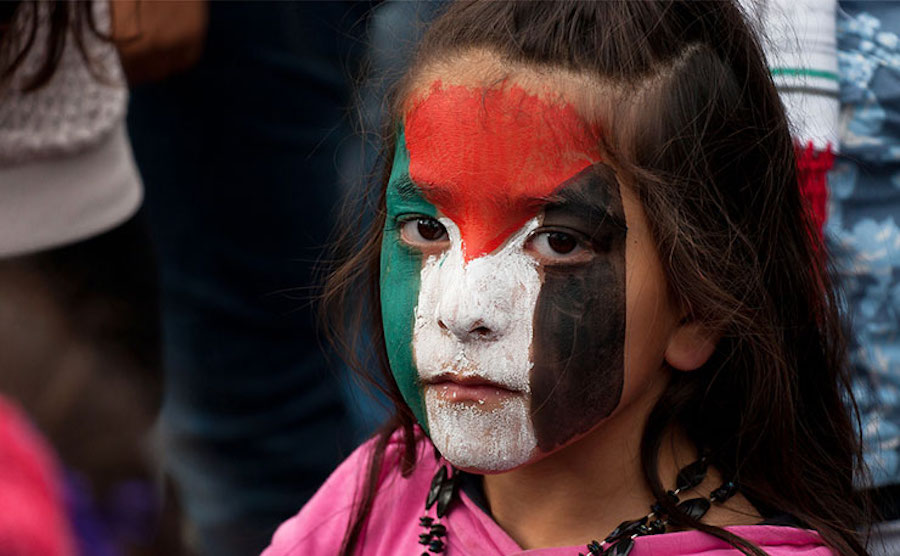Competing visions of the BDS Boston Mapping Project
Obscuring the map

It is a familiar scene. A local group of pro-Palestine Boycott, Divestment, and Sanctions (BDS) activists undertake a normal bit of activism—in this case, power mapping the local institutions that contribute to their city’s support for the ethnic cleansing of Palestine. Zionists respond with spurious accusations of antisemitism. Dozens of Zionist institutions and hundreds of pro-Israel Jewish leaders put out statements of condemnation. They propagate misinformation claiming that the activists have targeted synagogues and generated threats of antisemitic violence against Jewish institutions. The manufactured outrage at lies told about the activists wins the support of politicians looking for any excuses to isolate and repress Palestinian activism—and, in this case, things go so far as provoking an FBI investigation into the activists. Thus, the Left is presented with a choice: which side are you on?
In the case of BDS Boston—a group that describes itself as a “group of activists devoted to building the Boycott, Divestment, Sanctions (BDS) movement in the greater Boston area in solidarity with Palestine”—and its recent Mapping Project, a significant portion of the Left, including the BDS National Committee (BNC), the self-proclaimed leadership of the BDS movement, chose the wrong side. On June 22, the BNC released a statement saying that the movement “has no connection to and does not endorse the Mapping Project,” adding that “[e]ndorsement of this project by any group affiliated with the BDS movement conflicts with this affiliation.” While the BNC condemned “the cynical use of this project as a pretext for repressive attacks on the Palestine solidarity movement by anti-Palestinian racists,” recognition of the obvious cynicism at play did not extend to the attacks on the Mapping Project.
Under the pressure of a particularly successful right-wing scare campaign, left-wing voices found a number of justifications for distancing themselves from the project. Some bought the Zionist line that the project effectively “doxxed” Jewish organizations or provided a “hit list” of Jewish institutions, with the implication that they should be targeted for violence. This smear is patently false, which is evident if one bothers to spend five minutes looking at the project. Setting aside the fact that the project only posted publicly available addresses and thus didn’t dox anyone, the vast majority of the map’s subjects weren’t Jewish institutions at all. Not a single synagogue was listed, presumably out of an abundance of caution, even though many synagogues in the Boston area are certainly implicated in the ethnic cleansing of Palestine. Most of the institutions listed were police stations, but you would never know it from the fear-mongering responses of the Zionist right.

In fact, the creators of the Mapping Project had almost the opposite goal in mind. Their project aimed to refocus activists’ attention away from Jewish and philosemitic ideological support for Zionism, and toward the white supremacist institutions in which Zionism is embedded. The map, put together by anonymous grassroots activists from Boston, “illustrates some ways in which institutional support for the colonization of Palestine is structurally tied to policing and systemic white supremacy here where we live, and to US imperialist projects in other countries.” It draws connections between weapons manufacturers, government agencies, politicians, and cultural institutions in order to visualize the totality of the ways in which support for Zionism infiltrates and gets laundered through everyday life in the United States. In doing so, it implicitly critiques the kind of liberal anti-Zionism that sees Zionism as an anomaly within U.S. policy. A strategy of allying with liberal politicians who think there are better uses for tax dollars does not strike nearly deep enough at the problem. Rather, the map seems to suggest, Zionism is everywhere, and it is rooted in the kinds of cultural and political practices that make up the background of U.S. institutional life. Zionism, as the map shows, is in our museums, our police stations, our consulting firms, our hospitals, and especially our defense infrastructure. This is the useful contribution the map makes to the movement–not the research itself so much as the political refocusing.
Much of the Left, however, didn’t see it this way. Even if they didn’t buy into Zionist fear mongering, the map had taken aim at the accomodationist and conciliatory strategies of much of the Palestine solidarity movement in recent years—especially in its condemnation of progressive politicians like Ed Markey and Elizabeth Warren—and many would-be allies took the side of the the Mapping Project’s reactionary opposition.
On a recent podcast, Jewish Currents suggested that the project was “sloppy” and “conspiratorial.” Repeatedly, the hosts framed their critique as a challenge to the project’s efficacy and utility, not its righteousness, but in the course of the episode, they defended liberal Zionist organizations like the New Israel Fund and J Street, as well as Jewish day schools that collaborate with Zionist organizations. They argued that while the project’s authors were likely not antisemitic, it couldn’t be ruled out.
Similarly, Mondoweiss published an essay from Nora Lester Murad entitled “The Mapping Project is not antisemitic but it is destructive activism.” The bulk of the article is a series of pseudo-pragmatic grievances: that it wasn’t useful to put the relevant institutions on a map and that the project had failed to prepare a media strategy with other activists before going public. But her central argument is that the real crime of the activists was failing to convince a right-wing Jewish audience that their project was targeting Zionism and not Jews. In Murad’s words, the project did not “work…hard [enough] to consider the comfort of (mostly white, mostly Jewish) people.”
These critiques are helpful when evaluating the reasoning of the BNC’s behind-closed-doors decision making around the project. Officially, the BNC claimed that the Mapping Project had violated its affiliation guidelines by supporting “resistance in all its forms”—a phrase which the BNC took to include armed struggle. But BDS collectives make such statements all the time. It is clear that the BNC was motivated more by the public outcry around the Mapping Project than around the actual content of the project itself. The Mapping Project simply ruffled too many feathers, and as pro-Palestine voices accommodated to the politics and terms of the debate imposed by the Zionist right, they couched their ultimate disapproval of the project’s uncompromising truth-telling in the language of pragmatism and the need for careful messaging.
This attempted appeasement of the anti-Palestinian fake-outrage machine comes on the heels of another capitulation by the BNC. In the midst of the Bowman Affair within the Democratic Socialists of America (DSA), covered extensively by Tempest, the BNC weighed in with a thinly veiled statement understood by many as granting DSA’s undemocratic leadership a green light to refrain from expelling Zionist Congressman Jamaal Bowman, despite his votes in favor of $3.3 billion in direct military aid to Israel and $1 billion in funding for Israel’s Iron Dome program and his tour of Israel with J-Street.
The BNC’s statement was used extensively by the DSA leadership’s apologists and Zionists in the organization to justify attacking Palestinian DSA activists. Shortly thereafter, the National Political Committee (NPC) announced its decision not to expel Bowman, citing the BNC’s statement. The NPC barred the BDS and Palestine Solidarity Working Group from DSA leadership and succeeded in getting the Working Group’s Twitter account suspended for a number of months.
If the Palestine solidarity movement follows the BNC in prioritizing relationships with liberal Zionist politicians over the principled activity of grassroots BDS activists, it would be a disaster for the movement. Fortunately, Palestinian organizations that are involved in the on-the-ground organizing that has built BDS’s popularity in the United States have almost universally distanced themselves from the BNC’s actions in both instances. National Students for Justice in Palestine, the U.S. Palestinian Community Network, the Palestinian Youth Movement (PYM), Samidoun: Palestinian Prisoner Solidarity Network, Within Our Lifetime, and Al-Awda: The Palestine Right to Return Coalition, along with a host of local BDS collectives and Palestine solidarity organizing committees, have all voiced support for the Boston Mapping Project. The Palestinian Youth Movement led twenty organizations in reiterating support for the project, arguing, “No one in our movement has a monopoly on movement tactics, including BDS.” PYM recognized that the issue is not poor messaging by Boston BDS, but its “commitment to uncovering the connections between policing, imperialism, and Zionist colonialism.”
At the same time, the BNC’s opportunism has emboldened elements of the Palestine solidarity movement seeking to tone police their way to freedom and effectively isolated Palestinian organizers from the networks of support they previously enjoyed from non-Palestinian activists, particularly from Jewish organizations and activists. In addition to the Jewish Currents response, IfNotNow has been silent about the attacks on the Mapping Project, and many of its most prominent members have been vocal in opposition. Both Jewish Voice for Peace and former JVP Executive Director Rebecca Vilkomerson tweeted in support of the project before later deleting those tweets after public opposition from prominent JVP members. Ariel Gold, the national co-director of the pro-Palestine and anti-imperialist organization CODEPINK, has vocally condemned the Mapping Project for “target[ing] Jewish teen and youth organizations,” saying, “We should all fear a massacre of Jewish youth as a result.”
These organizations and activists share with the BNC an orientation on moving constituencies fundamentally hostile to the project of Palestinian liberation—be they politicians in an imperialist, settler-colonial state aligned with Zionism, or else ruling-class Jewish institutions that actively abet and benefit from the ongoing colonization of Palestine.
BDS has been successful in shifting the narrative around Palestine in the United States precisely because it has focused on connecting the liberatory struggle of Palestinians with the struggles of oppressed people here. Whereas two decades ago, even the most reserved support for a general notion of Palestinian human rights was a non-starter on the national political stage, the shift in public attitudes brought about by the BDS movement–and particularly its engagement with the struggles of other oppressed people in the United States–has begun to change that. This has meant that strategies relying on congressional advocacy have appeared to come within reach, at least for the liberal wing of the Palestine solidarity movement. In centering this strategy, however, forces like the BNC have become willing to give up the very strategies that created their power in the first place. The appearance of Palestine-sympathetic politicians on the national stage is not a cause, but a product of the realization by the oppressed and exploited majority in the United States that they share a freedom struggle with the Palestinians. But this opening among the elite has emboldened the wing of the movement that seeks to circumvent solidarity in the name of proximity to power.

The Boston map controversy is not just about “resistance in all its forms,” or producing a more polished project that refrains from visualizing information. It isn’t about whether the Mapping Project is strategic, but whether it is true. The disagreement rests on competing visions for the future of the Palestine solidarity struggle: one vision of a liberal advocacy constituency engaged in hyper-specific economic and legislative campaigns; and one that situates Zionism firmly within the structures of U.S. empire—structures that can only be toppled by mass revolt. With the BNC and other forces beginning to play a conservative role in the movement, socialists should move to support the leadership of the acting vanguard of the Palestinian freedom struggle in this country, the Palestinian organizations refusing to buckle under Zionist pressure and going toe to toe with the totality of US empire.
Categories
We want to hear what you think. Contact us at editors@tempestmag.org. And if you've enjoyed what you've read, please consider donating to support our work:
DonateJonah ben Avraham View All
Jonah ben Avraham is a Midwest-based socialist and anti-fascist activist. He is a member of the Tempest Collective.
